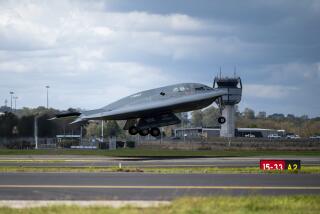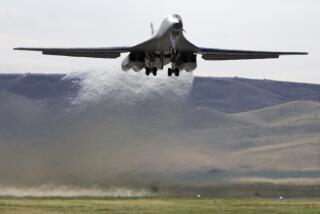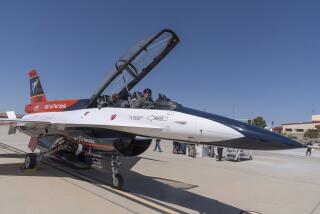Stealth Bomber Ends Successful 3rd Test Flight
- Share via
EDWARDS AIR FORCE BASE — The B-2 Stealth bomber ended the longest and most secretive of its three test flights over the Mojave Desert on Saturday with a safe landing here, an Air Force spokesman said.
The bomber, which resembles a bat, took off at 8:30 a.m. from Edwards Air Force Base and landed there four hours and 36 minutes later, Capt. Tess Taft said.
Brig. Gen. Richard M. Scofield, program director for B-2 System Program Office, called the bomber’s third flight successful. “We are extremely pleased with today’s mission,” Scofield said in a prepared statement.
The B-2’s flight Saturday “was by far the longest, highest and fastest thus far,” Taft said.
The aircraft flew at 25,000 feet and at speeds of up to 300 knots, or about 345 m.p.h., she said. In the previous two flights, the bomber never exceeded a height of 10,000 feet, speed of 180 knots or two hours in the air.
“The primary mission was to check out the systems and see how it flies,” she said. “That’s what test flights are for, to go a little bit higher, fly a little bit faster.”
As in the July 17 and Aug. 16 flights, the bomber was piloted by Air Force Col. Richard S. Couch and Northrop chief test pilot Bruce Hinds, Taft said.
She did not have any other details about the flight.
The abbreviated second test flight of the radar-evading B-2 on Aug. 16 was scrubbed in mid-flight because of a tiny crack in a part provided by a defense contractor once fined for billing fraud.
A hairline crack in a casing of an accessory drive, which powers the $530-million jet’s generators and controls, caused oil pressure to drop during the earlier test flight, Taft said Friday.
The bomber’s two-hour maiden flight was called a success.
Unlike the previous two test flights, the flight Saturday was not announced in advance by the Air Force.
The government has spent about $22.4 billion on the B-2 program, which is 18 months behind schedule. Congress has balked at paying more than $500 million apiece for 132 bombers.
Engineers claim that the use of composite materials combined with its smooth leading edges give the bomber a tiny radar signature making it nearly impossible for Soviet systems to detect.
More to Read
Sign up for Essential California
The most important California stories and recommendations in your inbox every morning.
You may occasionally receive promotional content from the Los Angeles Times.










